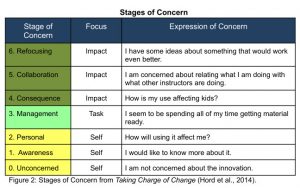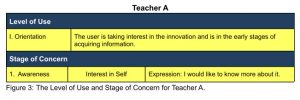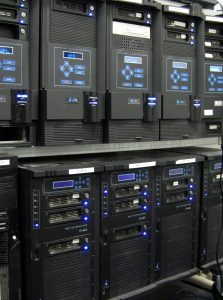Introduction to CBAM
The task of reference services is to connect users of the Library Learning Commons (LLC) with the information they need. One way of doing that is providing the information they seek through a method like the Reference Interview (Riedling and Houston, 2019). However, this is a somewhat hierarchical method. A different method – that involves increasing the information literacy of and collaboration with the users of the LLC, is to evolve their practice. This report will examine the use of the Concerns-Based Adoption Model (CBAM) to evolve the practice of two teachers in this educational program.

The Concerns-Based Adoption Model is a framework to support people in changing their practice. The key for the adoption of innovation is the intended innovator (Oris, n.d.). Often teachers are taught how to perform a task while they still have significant questions and concerns about the process (Loucks-Horsley, 1996). “CBAM is a process providing individuals the opportunity to address their own needs and time frame” (Oris, n.d.) in order to increase the likelihood that a new task or process is adopted. The CBAM process is different from other models like the Substitution Augmentation Modification Redefinition (SAMR) Model. The SAMR focuses on functional change in the classroom (Technology is Learning, n.d.), but not on the role of the teacher. What’s important about the CBAM model is that it’s not just about providing information and skills about implementing a new technology or process, but instead includes emotional support during implementation. The two teachers involved in this report are Teacher A and Teacher B. These teachers are at two very different levels with regard to the effective use of reference materials.

Supporting Teacher A
Teacher A is a classroom teacher who specialises in the humanities at a senior level. They use basic reference materials that are available in the classroom, such as dictionaries and thesaurus. When further information is needed, such as when students are looking for information to complete projects, Teacher A directs their students to Google searches and Wikipedia. They are aware that there are reference resources available through the LLC website, but while they haven’t made any steps to log in or otherwise access them, they have expressed interest in their use. According to the Concerns-Based Adoption Model, Teacher A is at the second level of use, which is “Orientation” (Huang, n.d.). Individuals at this level of use are still acquiring information about the process and are seeking information to get started on integrating reference resources in the classroom. Emotionally, Teacher A is at the “Awareness” Stage of Concern according to the CBAM model (Loucks-Horsley, 1996). Their concerns mostly involve themselves and thoughts about their ability to teach the use of reference materials.

Teacher A requires direct information and training in order to increase their classroom use of reference resources. I would support them by providing:
- Encouragement.
- I would let this teacher know they are capable of using reference materials; and
- I would provide assistance to limit frustration.
- Teaching.
- I would ask if they need help using reference resources;
- I would directly supply information on available services and how they’re used; and
- I would teach workshops and professional development sessions.
- Direction.
- I would direct this teacher towards reference materials, especially digital reference materials like EBSCOhost and GALE (found here);
- I would direct this teacher towards resources on using reference materials, such as online tutorials (like these); and
- I would direct this teacher towards workshops and professional development sessions.
- Monitoring.
- I would monitor this teacher’s progress as they progress towards full use of reference resources (approximately three years).
The District Learning Commons (DLC) E-Resource List hosts digital reference resources such as EBSCOhost and GALE. Link.
Supporting Teacher B
Teacher B is a classroom teacher who specialises in intermediate science. They have become increasingly aware of the reference services available through the library and are increasingly incorporating their use in the classroom. Teacher B teaches basic information literacy as a unit in their courses. They collaborate with the school TLs, and schedule a time for their classes to visit the LLC and receive instruction about library services. The TL shows their students where to access various library resources and what digital resources are available through the District Learning Commons. Teacher B directs students to the reference materials on the LLC webpage when students are involved in research. According to the Concerns-Based Adoption Model, Teacher B is at the fourth level of use, which is “Mechanical” (Huang, n.d.). Individuals at this stage are focused on the immediate use of the library references. Emotionally, Teacher B is at the “Management” stage of Concern according to the CBAM model. Individuals at this stage of concern are often focussed on the task itself, rather than the results and impact of the activity (Loucks-Horsley, 1996).

Teacher B requires consultation and collaboration in order to increase the effectiveness of their use of reference resources. To move past purely mechanical work and towards integration that increases the overall informational literacy of their students I would support them by providing:
- Encouragement.
- I would congratulate this teacher on the progress that they’ve made; and
- I would reassure them that they can further increase the informational literacy of his students.
- Consultation.
- I would mentor them to see what they’re doing what assistance they still need; and
- I would direct them to valuable resources and give them suggestions on how to improve their practice.
- Collaboration.
- I would collaborate with this teacher “to infuse information literacy instruction in learning experiences” (CSL, 2020);
- I work with this teacher, perhaps with co-teaching or co-operative lesson planning, to improve their classroom integration of reference resources; and
- I would also seek to connect them to colleagues that have further implemented the use of research resources.
- Monitoring.
- I would continue to monitor this teacher’s progress as they progress towards full use of reference resources (approximately one to two years).

Figure 5: A server farm. Digital reference resources, accessible online and stored on servers like the ones pictured above, are increasingly relevant resources for school research (Law, 2005).
Conclusion
Teachers require more than just information in order to integrate new technologies and processes into their practice. The CBAM Model is a method that supports teachers, in both their emotional and intellectual needs, at various stages of their adoption of reference resources. Teacher A requires direct instruction and training in order to begin using Library Learning Centre reference resources in their classroom. However, even teachers that are initially doing well can benefit from assistance as they adapt to new processes. Teacher B also needs support so that their use of reference resources doesn’t remain focused on the mechanics of the process. Frustration and abandonment of innovation can occur at any stage of use within the CBAM model. Therefore, teachers need to be continuously supported as they progress through the process of increasing their reference resource use. With adequate assistance, both of these teachers can progress to the very last stages of use, where their use of reference resources is refined and innovative.
Link to Microsoft Word document version of this report.
References
Canadian School Libraries (CSL). 2020. Leading Learning: Standards of Practice for School Library Learning Commons in Canada. Retrieved March 2, 2023, from http://llsop.canadianschoollibraries.ca
Hord, S. M., Rutherford, W. L., Huling, L., & Hall, G. E. (2014). Taking Charge of Change (PDF Ed.). Southwest Educational Development Laboratory. Retrieved March 7, 2023, from https://sedl.org/pubs/change22/taking-charge-of-change-2014.pdf
Huang, P.S. (n.d.). Levels of Use. Concerns-Based Adoption Model. Retrieved March 2, 2023, from https://sites.google.com/site/ch7cbam/home/levels-of-use
Law, S. (2005). Server farm [photograph]. Retrieved March 8, 2023, from (https://www.flickr.com/photos/50642338@N00/78981814) CC BY 2.0.
Loucks-Horsley, S. (1996). Professional Development for Science Education: A Critical and Immediate Challenge. Retrieved March 2, 2023, from https://s3.wp.wsu.edu/uploads/sites/731/2015/07/CBAM-explanation.pdf
Oris, A. (n.d.). Intro to CBAM – Concerns-Based Adoption Model. Concerns-Based Adoption Model. Retrieved March 2, 2023, from https://sites.google.com/site/ch7cbam/home/introduction
Riedling, A. M. & Houston, C. (2019). Reference Skills for the School Librarian: Tools and Tips, 4th Edition. Libraries Unlimited.
SD57 DLC (n.d.). School District 57 District Learning Commons Discovery Learning Portal. https://prin.ent.sirsidynix.net/client/en_US/dlc/?rm=E-RESOURCES+%28N0%7C%7C%7C1%7C%7C%7C1%7C%7C%7Ctrue&lang=EN
Technology is Learning. (n.d.). SAMR Model. Retrieved March 7, 2023, from https://sites.google.com/a/msad60.org/technology-is-learning/samr-model

I was just talking about mentoring as a TL and it’s value. I realized that I had a preconceived idea of what collaboration meant. Collaboration means that you are working together to get a certain outcome. To me it would mean that the input of the teacher is just as valuable if not, more important than the TL’s. However, sometimes collaboration has to look different because of where the teacher is according to CBAM. Using this model has shifted my perspective because using the model for different teachers will allow me to tailor my assistance/collaboration according to their concerns and not make any assumptions! In some cases it will mean coming up with a unit together and in others it will mean modelling for the teacher so that they can learn to do something new.
Yeah, I think collaboration is whenever two people work together to create a product. The partners in the collaboration don’t necessarily have to be at the same skill level in all areas. Sometimes skills sets are equal, sometimes they’re complementary, and sometimes they’re unequal. Sometimes collaboration is used because the TL and classroom teacher have different areas of expertise, and sometimes collaboration can be used as a teaching tool.
The CBAM model is interesting since my colleague was proof reading my paper. My colleague is much older than me, and she’s been a teacher through several ministerial innovations. She actually asked for links to the classroom resources, since in her experience, intellectual and emotional support has been lacking in the educational policy changes she’s experienced.
I would have to agree with your college! Especially the inclusion of emotional support in classrooms. I notice that the need for this has dramatically increased yet the academics is still prioritized over the emotional. I would consider behavioral expectations to be included in that. In my experience there has never been a bigger need for supporting students in this area!